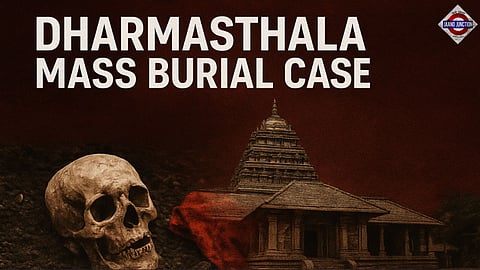

Dharmasthala is a well-known temple town in Karnataka, located on the banks of the Nethravathi River in Dakshina Kannada district. The town is famous for the Dharmasthala Temple dedicated to Lord Manjunatha. It is unique because while the temple is a Hindu place of worship, its administration is managed by a Jain family. Rituals are performed by Vaishnava priests, and the site draws thousands of pilgrims every day.
What is the Dharmshthala case and how it began?
In July 2025, shocking allegations surfaced against Dharmasthala. A Dalit caretaker claimed he had been forced to bury the remains of women and children who were victims of rape and murder between 1996 and 2014. He alleged that the temple grounds and surrounding areas contained mass graves, holding hundreds of bodies.
These claims caused huge public outrage and drew attention from activists, journalists, and the legal community. The case soon moved from local whispers to national headlines.
Following the caretaker’s testimony, a formal complaint was filed. On July 4, police opened a case against the temple authorities. By July 10, the complainant was given police protection. A day later, he presented skeletal remains which he claimed he had exhumed earlier.
Amid growing pressure, a team of lawyers led by senior activist S. Balan met Chief Minister Siddaramaiah. This led to the case being handed over to a Special Investigation Team (SIT) headed by Director General of Police Pronab Mohanty.
The SIT dug at multiple spots along the Nethravathi River and nearby areas named by the complainant.
First five sites: no remains.
Site 6 (July 31): 15 bones (no skull), some broken; early note suggested male.
Other spots: mostly nothing; one site had a skull and bones.
Site 14: 100+ bones and a skull found with a red sari nearby; early talk pointed to a male and possible strangulation, pending forensics.
A PAN card and debit card found at one dig traced back to a man who died of jaundice and was cremated in his own village,unrelated to the alleged crimes.
In total, several sites showed no evidence, while a few yielded bones. Forensic tests are ongoing.
On July 18, Judge Vijaya Kumar Rai B ordered the removal of over 800 online links related to the case.
Journalists pointed out the judge had past connections with institutions linked to Dharmasthala.
By August 4, he recused himself from the case.
Later, another court granted an injunction suppressing over 8,800 media items about the allegations.
Critics called these gag orders attempts to suppress public debate.
New twist: The Whistleblower’s arrest
On August 23, the SIT arrested the complainant after spotting inconsistencies in his statements and paperwork. Media reports suggest that one of the reasons cited was his claim about a skull, which investigators later said was false. He was sent to 10 days’ custody while questioning continues.
Reactions
Temple side:The Dharmadhikari of Dharmasthala,Dr. D. Veerendra Heggade welcomed the arrest, calling the allegations baseless and “deeply hurtful,” and said the truth is beginning to come out.
Politics: Some opposition voices said the government should apologize for allowing the charges to spread; others demanded probes into a possible conspiracy to defame Hindu temples. The Home Minister confirmed the arrest and said the investigation continues.
Locals/family: The complainant’s ex-wife publicly called him a “habitual liar,” alleging past dishonesty and saying he never spoke of such murders during their marriage.
A key witness’s U-turn
Sujata (Sujatha) Bhat, who earlier said her daughter went missing in Dharmasthala in 2003, withdrew that claim, saying there was no such daughter. Later, she said she was pressured by a YouTuber to make that denial, another U-turn that has added to confusion around the case.
In parallel, police cracked down on fake news. A YouTube creator who made an AI-generated video about the case was charged with spreading misinformation. Karnataka’s Home Minister, G. Parameshwara, also warned the public against posting unverified claims on social media.
Activists and legal experts argue that the investigation has been too limited and non-transparent. They say digging at only a handful of sites cannot match the seriousness of the allegations. Some police officials were rumored to have sought withdrawal from the case, though authorities denied this.
Supporters of the temple, on the other hand, maintain that the allegations are exaggerated or politically motivated, pointing to the absence of remains at most excavation spots.
The Dharmasthala mass burial case now hangs between shocking truth and fabricated lies. The whistleblower’s arrest has raised doubts, yet the unearthed bones and unanswered questions still leave shadows. If true, it points to crimes buried deep within one of Karnataka’s most respected institutions. If false, it exposes how faith and reputation can be scarred by misinformation.
At its heart, this is about justice– for the nameless remains, for devotees, and for the people who deserve clarity. The haunting question remains: Will the truth of Dharmasthala ever emerge, or stay buried forever?
